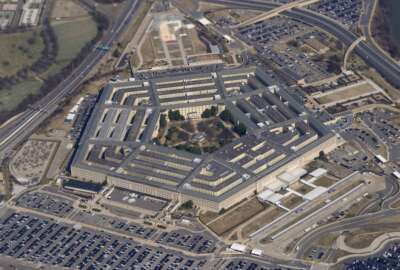Army plans to begin four ‘utility-scale’ renewable energy projects this year
The four acquisition decisions the service will make in the coming months are the first fruits of a task force the Army created to pursue large-scale solar, geo...
The Army plans to take acquisition actions on its first four “utility-scale” renewable power facilities within the next few months, taking spare land on its installations throughout the U.S. and using it to generate power that will make the bases more energy independent, officials said Tuesday.
The schedule is subject to change, but if all goes as planned, the Army will make acquisition decisions for all four large solar installations by this October. The sites are at Fort Detrick, Md., Fort Bliss, Texas, Fort Irwin, Calif., and U.S. Army Garrison-Hawaii.
“When completed, these projects are going to represent over 100 megawatts of power, moving the Army 10 percent toward its one gigawatt goal,” said John Lushetsky, executive director of the Army Energy Initiatives Task Force (EITF).
The task force was first formed nine months ago to start assessing the Army’s options for major renewable energy projects to create business deals that will have industry build them using third-party financing and a streamlined acquisition process.
Lushetsky made the announcement Tuesday at a joint Army-Air Force industry day on renewable energy. Both services have committed to generating a gigawatt of renewable power on their respective bases by 2025. He says the four major acquisition decisions the Army plans to make this year will increase the Army’s renewable energy investments by a factor of 10 and start moving the service toward its goal of being resilient against disruptions to the civilian power grid.
“All of these projects are being specified to provide a base level of energy security to these installations, a first step toward full energy security,” he said. “They will have the potential to increase their performance with additional renewables, the addition of microgrids, and energy storage and other clean energy technologies as they mature and become cost effective.”
The Army wants that microgrid and energy storage capability because of the intermittent nature of renewable technologies like wind and solar. The service is telling renewable energy firms that if they can provide that capability today in a cost-effective way, they’ll definitely buy it. But the large new systems need to be able to at least add them on at a future date.
Kathy Ahsing, the Army task force’s director of planning and development, says the push toward installation energy security isn’t just about preparing for a future disaster on the power grid. It’s about solving problems the Army faces right now.
“We have many installations right now out in the Army that are faced with multiple brownouts and blackouts, so that’s an area we’re going to focus on as we look at which installations we move towards,” she said. “We’ll also get price stability. Many states have volatile electrical power rates. There are economic benefits. Defense is facing over $400 billion cut to our budgets, and so cost of energy is important to us. Economics will matter as we look at the opportunities we pursue in the future.”
For the projects the Army plans to award this year, the energy produced by the solar arrays will be bought by the Army and consumed entirely by the local base, except for the 50-megawatt installation in Hawaii. There, the solar arrays will be built under a lease agreement with the local utility company and directed to the civilian power grid. But under the memorandum of understanding the Army is planning to sign, the Army will be able to take over control of the electricity produced in the event of an emergency.
Lushetsky said even though the first four projects the Energy Initiatives Task Force is setting up are solar photovoltaic systems, industry shouldn’t necessarily take that as a sign of what’s to come. He said it’s the beginning of a process on the Army’s glide-path toward a gigawatt of renewable power by 2025. Within the next few years, the service hopes to begin adding 100 new megawatts of renewable power to its bases each year.
He said the plan came about after the task force started surveying all of the Army’s real estate over the last nine months, and the task force has met with nearly a hundred companies to assess the state of technology and precisely where that technology might work.
“To date, the EITF has screened more than 180 Army and National Guard sites to identify the ones that have the best potential for renewable energy development,” he said. “We have developed and are applying a set of advanced optimization tools to cost-effectively meet Army renewable energy goals. We’ve also developed key processes and procedures for qualifying and developing projects for Army acquisition. We have eight specific factors we look at for each project, and a description of those procedures are going to be captured in a renewable energy project development guide that’s currently being finalized and should be published later this summer.”
Also on the horizon for the Army’s renewable energy plans is the release of a $7 billion request for proposals under a multiple-award contract the service wants to create. Under that contract, the Army would issue task orders for companies to build and operate renewable power plants on government land for up to 30 years using private sector financing. The Army would then buy the energy those plants produce through power purchase agreements. Officials expect to release the RFP by the end of next month.
RELATED STORIES: Army to trade land for renewable energy
Army, Air Force team up to meet renewable energy goals
Army to meet renewable energy goals through predictability
Copyright © 2024 Federal News Network. All rights reserved. This website is not intended for users located within the European Economic Area.
Jared Serbu is deputy editor of Federal News Network and reports on the Defense Department’s contracting, legislative, workforce and IT issues.
Follow @jserbuWFED






